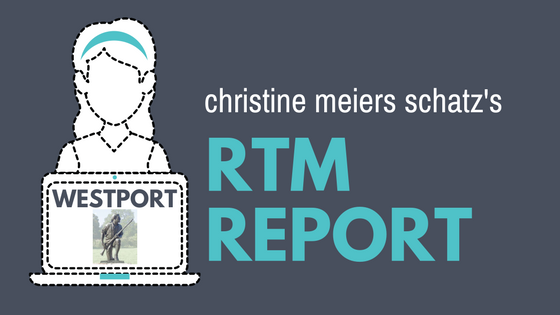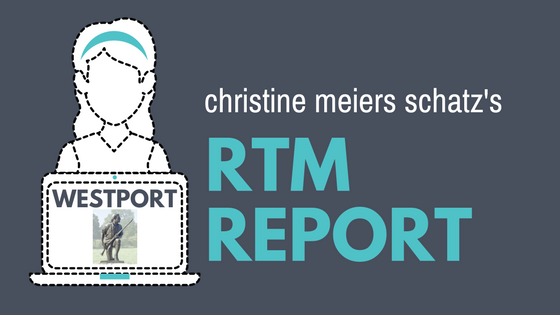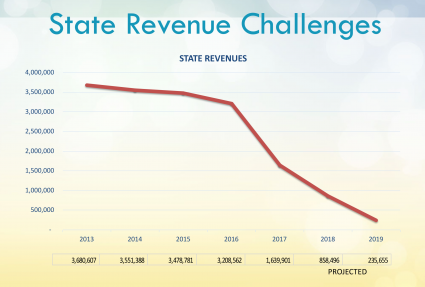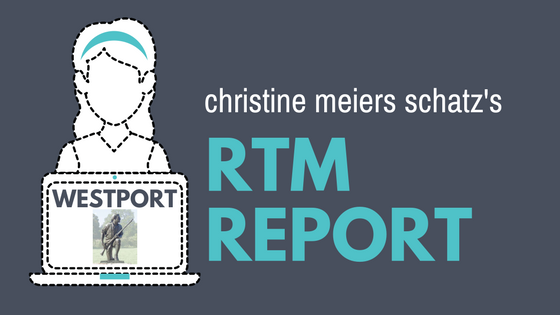SHORT SUMMARY:
Disclaimer: What’s below is my interpretation of the meeting and not an official communication from the RTM.
The RTM did the following:
- Approved the First Selectman's budget of $80,179,853 (an increase of 0.93% from FY 2017-2018),
- Approved the Board of Education's budget of $116,173,800 (an increase of 1.57% from FY 2017-2018) and the total Education budget of $127,313,182 (an increase of 1.09% from FY 2017-2018),
- Approved the Town Railroad Parking Fund Budget of $1,832,990 (up 0.30% from FY 2017-2018),
- Approved the Town Sewer Fund Budget of $4,783,623 (up 1.10% from FY 2017-2018),
- Approved the Wakeman Town Farm Fund Budget of $220,728 (down 22.60% from FY 2017-2018),
- Formalized certain logistics related to the timing of tax payments,
- Listened to the first reading of a proposed ordinance prohibiting the use of artificial turf containing synthetic infill,
- Ratified the collective bargaining agreement between the town and the Westport Municipal Employees Union,
- Appropriated $150,000 to purchase a combination garbage and recycling truck for the Parks and Recreation Department,
- Appropriated $950,000 to bury utility lines and reconstruct the Elm Street roadway with new sidewalks and lighting, and
- Appropriated $360,000 for the repair of a headwall and 3 culverts under Canal Road.
DETAIL:
There was no public comment, few questions, and very little discussion at the RTM meetings on Monday, May 7th and Tuesday, May 8th. Given the lack of material to report on, I've added some additional details learned from interviews, reports, and subsequent events.
AGENDA ITEMS #1 through #6: The approval of the total town budget of $207,493,035 for fiscal year 2018-2019 (up 1.03% compared to FY 2017-2018) and appropriation of that amount
THE BIG PICTURE:
On Monday, the RTM addressed every agenda item except for the Education budget, which it approved on Tuesday along with the total town budget of $207,493,035. Compared to fiscal year 2017-2018, the total budget approved by the RTM increased by 1.03%.
Following the meeting, the town adjusted the budget downwards by approximately $556,410, for a total budget of $206,936,368 - a 0.76% increase compared to fiscal year 2017-2018. The adjustments consisted of an additional $67,000 in anticipated costs related to contract negotiations with the Department of Public Works, which was offset by a reduction of $623,410 for settlements with the Police Department, Fire Department, and general town (non-education) employees.
Revenues also surpassed the town's projections. The state provided us with an unanticipated $800,000, and the town collected an additional $1.2 million in taxes. The better-than expected tax revenue included the repayment of deferred taxes from home sale proceeds.
On May 16, the Board of Finance voted unanimously to keep the mill rate flat at 16.86. To do so, the Board of Finance approved drawing down the town's general reserve account by $3.6 million. The reserve balance is now approximately 10.5% of annual operating expenses, which is on the upper end of the town's preferred 9%-11% window.
Note that we will not be able to rely on the reserve indefinitely to keep the mill rate flat - either taxes will need to increase, our total budget will need to decrease, our grand list and revenues will need to continue to grow, or some combination of these occurrences will have to take place. The town is moving in the right direction, though. The $3.6 million draw down of the reserve is smaller than the $4.4 million, $4.2 million, $5.34 million, and $4.25 million used to keep the mill rate flat in fiscal years 2014-2015 through 2017-2018, respectively. In addition, our grand list growth this year of 1.5% exceeds our peer towns. For example, the grand lists in Darien, Norwalk, New Canaan, Wilton, Weston, and Fairfield grew by approximately 0.9%, 0.5%, 0.6%, 0.6%, 0.6% and 0.3%, respectively. According to town Finance Director Gary Conrad, the improvement in Westport's grand list this year is due in part to increased commercial development, residential renovations, and the continued recovery of home values near the shore since Hurricane Sandy.
THE MEETING:
Sheri Gordon presented the budget on behalf of the Board of Finance, and I've included a video of her presentation. Please note there's a button on the lower right of the video that will make it full screen - otherwise the slides are too small to read.
My agenda summary post (available here) covers some of the important points made by Ms. Gordon; this was possible because town Finance Director Gary Conrad used the same slide deck at our RTM Finance Committee meeting. I've highlighted three additional graphics from the presentation below.
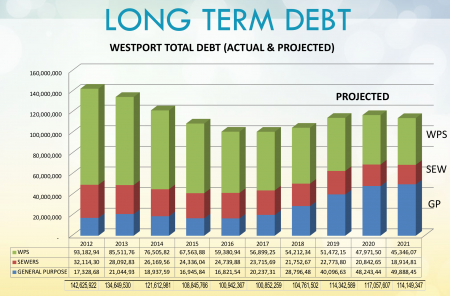 The first relates to long term debt (click on the slide to enlarge). The debt for general purpose town activities has been increasing since 2016 which, according to Ms. Gordon, was due to projects like the senior center and the library. The total town long term debt is projected to increase further by approximately $13 million between now and 2020, with this increase coming from more general purpose town debt. In committee, Mr. Conrad explained that this additional projected debt was for "catch up" projects that the town had deferred. All such expenditures would be subject to appropriation requests to the Board of Finance and RTM. As you can see in the slide, the school-related debt has decreased dramatically since 2012. This trend is projected to continue at a slower pace.
The first relates to long term debt (click on the slide to enlarge). The debt for general purpose town activities has been increasing since 2016 which, according to Ms. Gordon, was due to projects like the senior center and the library. The total town long term debt is projected to increase further by approximately $13 million between now and 2020, with this increase coming from more general purpose town debt. In committee, Mr. Conrad explained that this additional projected debt was for "catch up" projects that the town had deferred. All such expenditures would be subject to appropriation requests to the Board of Finance and RTM. As you can see in the slide, the school-related debt has decreased dramatically since 2012. This trend is projected to continue at a slower pace.
The second slide relates to town (non-education) employee headcount, which declined from 2009 to 2013 and has stayed relatively stable since then. According to the U.S. Census Bureau, the population in the Town of Westport is estimated to have grown by over 1,000 people - up 5.5% - between 2010 and 2016. The third slide shows the precipitous decline in state revenue since 2013 - a reality we're all aware of but that nevertheless makes for an interesting graph.
Ms. Gordon also went through each department's budget percentage increases compared to fiscal year 2017-2018, which are depicted in the chart below.
On Tuesday, the RTM unanimously approved the Board of Education budget, which I described in more detail in my last post (available here). At the RTM meeting, School Director of Operations Elio Longo explained how the proposed budget, as compared to fiscal year 2017-2018 went from over a 4% increase to an increase of 1.57%. These successful efforts included renegotiation of workers' compensation insurance and transportation contracts, and the switch of all Westport Public School employees to the state health insurance plan. Based on the approved budget, in the next few weeks the Board of Education will also need to find ways to reduce expenses by $972,000.
Although 1.57% may be a larger increase than some residents wanted to pay for, it's compares favorably to other districts that spend approximately the same amount per pupil. For example, the Board of Education budgets in New Canaan, Weston, and Wilton were up 2.45%, 3.10%, and 1.62%, respectively. In Greenwich, the Board of Education budget increased by 4.70% or 2.62% pro forma to exclude the effect of an accounting change. In my opinion, for what it is worth, the Superintendent, school administrators, and Board of Education did a good job under difficult circumstances this year. That seemed to be reflected in the lack of questions from the RTM and the unanimous vote to approve the Board of Education budget.
RTM member Jimmy Izzo cast the sole dissenting vote related to the education budget on the separate education line item for aid to private and parochial schools. He did so after questioning whether the aid was mandated by the state. Mr. Longo replied that it is. To my knowledge, this line item includes transportation expenses for Westport students to private schools in Westport, like Greens Farms Academy and the Pierrepont School.
With respect to tax-collection logistics, the RTM unanimously resolved that (a) motor vehicle taxes will be due in a single installment, (b) taxes in an amount of $100 or less will be due in a single installment on July 1, 2018, and (c) property taxes in an amount over $100 will be due in four installments on July 1, 2018, October 1, 2018, January 1, 2019, and April 1, 2019.
ADDITIONAL DETAIL:
Finally, while not mentioned at the RTM meeting, here's some notable budget-related information regarding two departments:
- Congratulations to District 2 resident-entity EARTHPLACE! In the past year, Earthplace program revenues have continued to grow for their preschool, nature programs, and summer camps - even while revenues at many of the other preschools were flat. In September the organization will launch a daycare program for newborns to two-year-olds and, at Staples High School, a 3s and 4s program. In its report for the full RTM, the Library, Museum, & Arts Committee wrote that it "was impressed with the leadership and direction of Earthplace with the limited funding they receive from the town." I've met one-on-one with the leadership at Earthplace as well and I was similarly impressed. In addition to its programming for children, Earthplace has classes and special events for adults; you can learn more at the Earthplace website.
- There was some interesting data in a POLICE DEPARTMENT report related to the budget:
- For fiscal year 2017, there was a 6.25% increase in calls for service, which was mostly due to increased motor vehicle-related complaints and enforcement. Traffic accidents in Westport parking lots increased as well.
- Narcotics violations increased by 91%. This increase may be due in part to the fact that the Police Department has been able to more easily identify situations where narcotics are present due to its relatively new K9 Unit.
- The number of death investigations increased from 10 to 23. Upon further inquiry I learned that, while most deaths were from natural causes, 2 college-aged students died from drug overdoses. This can happen in any family even with the very best parents - as some of you know, my brother died of a drug overdose as well. And it is one of many reasons why I founded my non-profit Sleep for Success Westport.
- Finally, as reported case by case in the news, incidents of larceny from motor vehicles and stolen motor vehicles have increased by 73% and 75%, respectively.
AGENDA ITEM #7: The first reading of a proposed ordinance prohibiting the use of artificial turf containing synthetic infill
The draft ordinance was sponsored by the RTM Environment Committee, which is chaired by Wendy Batteau and includes Diane Cady, Andrew Colabella, Nicole Klein, Ellen Lautenberg, Matthew Mandell, Carla Rea, Lauren Soloff, and Cathy Talmadge. The ordinance has been revised slightly from the version in the agenda and now reads as follows:
An Ordinance Prohibiting the Use of Artificial Turf Containing Synthetic Infill in the Town of Westport, Connecticut.
Purpose. To protect the health, safety and general welfare of Westport's children and all residents, ecosystems, and natural resources, the use of artificial turf containing synthetic infill manufactured from recycled or virgin materials including but not limited to ambient and cryogenic crumb rubber, coated crumb rubber, ethylene propylene diene monomer granules, thermoplastic elastomer granules, and recycled footwear, (categorized as "hazardous waste" and "special handling waste") is prohibited as follows:
Definitions.
(1) Artificial Turf. Any man-made surface manufactured from synthetic materials which simulate the appearance of live turf, grass, sod, or lawn.
(2) Synthetic Infill Material. Any man-made infill from recycled or virgin materials including but not limited to ambient and cryogenic crumb rubber, coated crumb rubber, ethylene propylene diene monomer granules, thermoplastic elastomer granules, and recycled footwear.
(3) Organic Infill Material. Any material utilizing organic components such as cork, coconut husks, rice husks, silica sand, or acrylic coated sand.B. Regulations
(1) The use of artificial turf containing synthetic infill materials shall be prohibited.
(2) The use of artificial turf containing organic infill materials or containing no infill material shall be permitted, provided that: (a) Such use is in compliance with all applicable environmental laws and regulations; and (b) Any infill is composed completely of organic materials; and (c) The use of artificial turf does not exceed the impervious coverage requirements
Ms. Batteau explained that the Environment Committee had been speaking about the proposed ordinance at its meetings and with town officials for several years, but the need for the ordinance has become clear for numerous reasons, including the following:
- Crumb rubber infill is hazardous waste;
- The state of Connecticut has labelled crumb rubber infill as "special handling waste," which means it is a threat to health and safety. Special handling waste sites have to have special safety measures including dust filtering masks and protection for every person using them, washing of clothes and motor vehicles, and special venting;
- Crumb rubber infill contains at least 96 chemicals. Half have been studied and, of those, 20% were identified as likely carcinogens and 40% were identified as irritants; and
- According to Ms. Batteau, several tons of this material is in our children's artificial turf playing fields. It gets into their mouths, ears, hair, shoes, clothing, and then gets tracked into our schools, cars, and homes. As the fields get used, the crumb rubber gets broken down into small particles that pollute the environment and damage the health of all Westport residents.
AGENDA ITEM #8: The ratification of the collective bargaining agreement between the Town of Westport and the Westport Municipal Employees Union and appropriation of the amounts required under that agreement
 The Westport Municipal Employees Union (the "WMEU" and, more specifically, Local 1303-387, Council 4, AFSCME, AFL-CIO) represents 64 town employees with a wide range of jobs, including engineers, conservation analysts, civilian dispatchers, and accounting assistants. With First Selectman Marpe's authorization, Personnel Director Ralph Chetcuti conducted the negotiations with the WMEU and likely saved the town thousands in legal fees.
The Westport Municipal Employees Union (the "WMEU" and, more specifically, Local 1303-387, Council 4, AFSCME, AFL-CIO) represents 64 town employees with a wide range of jobs, including engineers, conservation analysts, civilian dispatchers, and accounting assistants. With First Selectman Marpe's authorization, Personnel Director Ralph Chetcuti conducted the negotiations with the WMEU and likely saved the town thousands in legal fees.
At the meeting, Mr. Chetcuti explained that the parties were able to forego attorneys because it was a "simple negotiation" regarding wages and employee contributions to the health plan. He also described the collective bargaining agreement, which will cover the 4-year period from July 1, 2017 through June 30, 2021. Employees will get wage increases of 2.5% each fiscal year, which is in line with other union contracts in nearby communities. The employees will also contribute 11%, 12%, 13%, and 14% to the cost of health insurance for the fiscal years 2017-2018, 2018-2019, 2019-2020, and 2020-2021, respectively.
RTM member Kristan Hamlin cross-examined Mr. Chetcuti to elicit information regarding employee parity. Unlike WMEU members or other municipal employees, Police Department and Fire Department employees receive time and a half for hours spent training or providing training to other employees. Mr. Chetcuti said that the provisions providing for this additional pay likely originated in much older contracts and that he'd take a closer look at them in future negotiations with those departments.
To meet the town's obligations under the collective bargaining agreement with the WMEU, the RTM appropriated $91,959 and $94,258 for the fiscal years 2017-2018 and 2018-2019, respectively.
The RTM voted unanimously to ratify the agreement and approve the appropriations.
AGENDA ITEM #9: The appropriation of $150,000 (and authorization of the related bonds/notes) to purchase a combination garbage and recycling truck
Jennifer Fava, the Director of Parks and Recreation, provided the RTM with background information regarding her department's responsibility for collecting trash and recycling from around 230 receptacles throughout the parks, beaches, athletic fields, and the downtown area. Their current collection truck is over sixteen years old with an irreparably broken compacting unit. The new combination garbage and recycling truck will reduce the number of employee crews needed to complete the collection runs from two to one.
Ms. Fava explained that if the town outsourced this function instead: (1) the total cost would be significantly more expensive, even when compared to the cost of the new truck and labor expenses (2) the outside company would not change bags or pick up trash from the surrounding area, (3) the outside company wouldn't have the same flexibility to do additional runs when necessary and during certain events, and (4) the town wouldn't be able to use to truck for clean-up after severe weather events; outsourcing this function would be a significant expense as well.
The RTM voted unanimously to approve the appropriation.
AGENDA ITEM #10: The appropriation of $950,000 (and authorization of the related bonds/notes) to bury utility lines and reconstruct the Elm Street roadway with new sidewalks and lighting
Peter Ratkiewich, Director of Public Works, explained to the RTM that the requested appropriation would be used for new underground utilities, sidewalks, curbs, street lighting and roadway on Elm Street. The town must complete this work as part of its land swap agreement with local developer David Waldman, who plans to build a new, two-story retail and residential building at 35 Elm Street. As part of the deal, the town will receive .15449 acres across the road at 36 Elm Street to be used for parking in return for a .15395-acre property in the Baldwin Lot at 35 Elm Street.
Although the appropriation is for $950,000, the developer is obligated to pay the town $750,000 of this amount as part of the land swap deal.
RTM member Matthew Mandell took the podium to say that the work would benefit the community by completing the triangle downtown. According to Mr. Mandell, this upgrade will make the area more vibrant.
The RTM voted unanimously to approve the appropriation.
AGENDA ITEM #11: The appropriation of $360,000 (and authorization of the related bonds/notes) for the repair of a headwall and 3 culverts under Canal Road
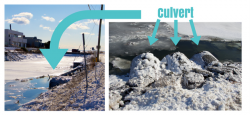 As you may recall and can read about here, funds for the design of this headwall were appropriated by the RTM in January 2018.
As you may recall and can read about here, funds for the design of this headwall were appropriated by the RTM in January 2018.
Mr. Ratkiewich described the work involved in repairing the eroded culverts and headwall, which he estimates will cost approximately $360,000. In response to a question by RTM member Kristan Hamlin, he explained that the job is currently out to bid and that his cost estimate was based on a database of all work that the town has done or contracted out. RTM member Peter Gold asked Mr. Ratkiewich to identify the lower-priority project in the capital forecast that the Canal Road project would replace. Mr. Ratkiewich said that the repair of the Willow Brook culvert on Weston Road would be postponed for a few years.
The RTM voted unanimously to approve the appropriation. The construction will begin after the school year is complete.
Disclaimer: What’s above is my interpretation of the agenda and not an official communication from the RTM.
